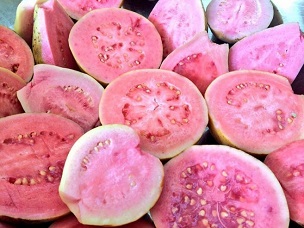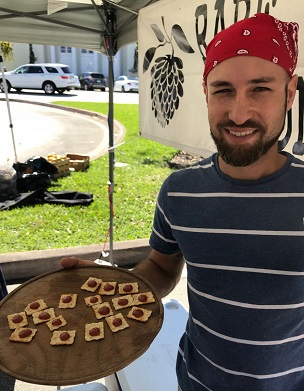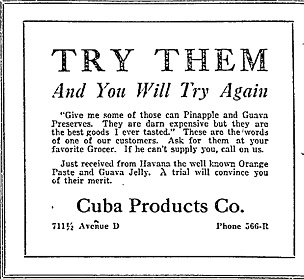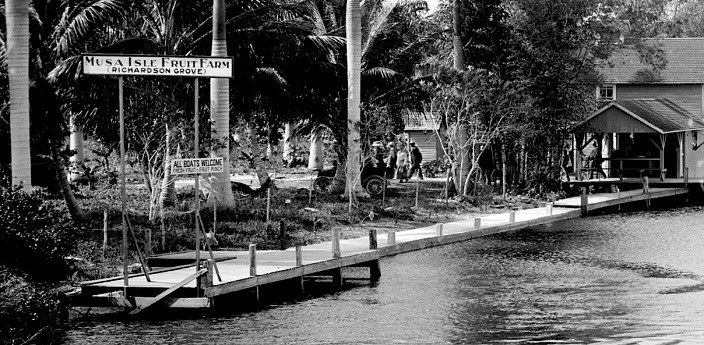Article from Edible
South Florida magazine
by Gretchen Schmidt, editor
The Glorious Guava
March 03, 2018

Fig.
1 Redland guava from Homestead
Guava is the sweet, seductive perfume that flavors many of
South
Florida’s favorite foods: pastelitos, ice cream, batidos, flans and
cheesecakes; sauces for pork, poultry, shrimp and beef; smoothies,
cocktails, even craft beer.
Preserves, pastes,
marmalades, jam
and nectar are essential to the Cuban pantry, although the source of
the fruits today is primarily Brazil, the Dominican Republic, Mexico,
Colombia and India. At the turn of the 20th century, however, guava was
a hot commodity for pioneers preserving and selling the exotic fruit
preserves to tourists and locals.
For more history,
we turned to
tropical fruit enthusiast Jorge J. Zaldivar, whose company, PG
Tropicals, sources locally grown, handpicked fruits from Guavonia Guava
Grove in Homestead’s Redland. He has sold his purees, marmalades, jams,
jellies and products to businesses, including Azucar Ice Cream, La
Fresa Francesa, Doce Provisions, Exquisito Chocolates, and the Burger
Museum. His passion for guava has led him to discoveries of its
importance to pioneers in Florida.
 | Fig.
2
Jorge Zaldivar of the Rare Fruit Council International
market tent at the Coral Gables farmers market. |
“The
history of the guava in Florida dates back more than 160 years ago,
when Col. H.V. Snell brought the fruit and seeds from Cuba to Sara Sota
(today’s Sarasota) and Manatee on the Gulf Coast,” says Zaldivar. “There
are endless accounts of guava trees growing wild in the oddest places
all around town, in and near Hialeah and everywhere else.” In Coconut
Grove, lawyer Albion Simmons and his wife, Dr. Eleanor Galt Simmons,
made guava jelly and wine in a building known as the Jelly Factory on
their property, now home to The Kampong, where plant explorer David
Fairchild lived. Simmons sold a ton of guava jelly to Henry Flagler for
his Royal Poinciana Hotel in Palm Beach, and also shipped guava jelly
to London in the late 1800s.
In his 1906 book, Life
and
Adventures in South Florida, Andrew P. Canova described his visit to
Miami’s Fort Dallas at the mouth of the Miami River: “Here we saw many
nice frame houses among the cocoa palm trees. … The guava bushes were
full of delicious fruit, and no one can say that we did not do them
ample justice. Next to a peach, I think the guava is the most
delightful fruit under the sun.”
Guavonia
in Coral Gables
“Throughout
Miami’s early years, the notion of community building is connected to
the guava,” says Zaldivar. “In 1898, the Solomon Merrick family moved
from Duxbury, Massachusetts, to a modest wood shack and wild guava
trees.” The family named the property Guavonia, where young George
Merrick would pick guavas and transport them by mule-driven wagon to
Capt. Simmons. In the High Pines section of what’s now South Miami, Mr.
and Mrs. William Laesch’s property had a large guava grove. Their 1901
house doubled as a guava jelly factory.

Fig. 3
Cuba
Products Co., merchant in Downtown Miami that sold
Cuban orange
paste, guava jelly, pineapple and guava preserves
On
the Miami River, near the NW 27th Avenue bridge, was Richardson’s Musa
Isle fruit farm at the turn of the 20th century. He may have formed the
first farming co-op in Miami by encouraging neighboring farmers to have
their fruit processed at his canning facility. One of his prized
products was guava jelly. Boats from the Royal Palm Hotel would come
down the Miami River with their guests at the grove. In 1907 the grove
was sold and became the Musa Isle Seminole Indian Village.

Fig. 4
Musa
Isle Fruit Farm (Richardson Grove) and the Cardale Tower
Miami
Fruit Industries became a major producer of Florida preserves,
marmalades, jellies and jams, and specialists in guava jelly.
“Headquartered in modern-day Midtown on 2nd Ave., with a multi-story
warehouse and production facility in Hialeah, they were able to
maintain a guava grove in Indiantown with advances in transportation,”
says Zaldivar. “By the 1930s, the Miami Herald was covering the booming
industry of crystallized fruits and marmalades,” including the Redland
Tropical Candy Company, the Florida Fruit & Preserving Co.
located
near the City of Miami cemetery, and Dr. Peterson’s Bonita Fruit
Preserving Co., in what’s now Little Haiti.
Redland Guava Today
In
the late 1950s and early 1960s, the Caribbean fruit fly was introduced
to Florida, creating problems for growers. By 2000, commercial acreage
expanded to around 300 acres, and in 2015, total guava production was
close to 600 acres, with more than 90 percent grown in Miami-Dade.
In
addition to researching guava’s illustrious past in South Florida,
Zaldivar is on a mission to bring the goodness of Redland guavas,
instead of crops sourced outside of the U.S., to the marketplace today.
“Guavonia Guava Grove has over 15 distinct heirloom guavas, each with
its own flavor,” he says. “Long live Redland guava!”
Grow
Your Own Guava Tree
Guava (Psidium guajava)
– guayaba in Spanish – is a member of the Myrtaceae family, which
includes the aromatic plants clove, bay rum, allspice and eucalyptus.
Native to the tropical Americas, guava grows easily in South Florida is
considered invasive in some areas. Trees grow to 20 feet and produce
two crops a year in the summer and spring, but with pruning can fruit
nearly year-round. Plant in full sun. Pick pink or red guava when the
peel turns light green to yellow and allow to ripen. Pick white guava
when full-sized and green to light green.
|
|
Bibliography
Schmidt, Gretchen. "Glorious Guavas." Edible South Florida, 3 Mar. 2018, ediblesouthflorida.ediblecommunities.com/eat/glorious-guava.
Accessed 9 Jan. 2019.
Photographs
Fig. 1 Zaldivar, Jorge. "Redland guava from Homestead." PG
Tropicals, 2015, ediblesouthflorida.ediblecommunities.com/eat/glorious-guava.
Accessed 9 Jan. 2019.
Fig. 2 Schmidt,
Gretchen. "Jorge
Zaldivar of PG Tropicals serving Redland guava tastes at the Coral
Gables farmers market." Edible South Florida, 3 Mar. 2018, ediblesouthflorida.ediblecommunities.com/eat/glorious-guava. Accessed
9 Jan. 2019.
Fig. 3 Cuba Products Co., merchant in
Downtown Miami that sold Cuban orange paste, guava jelly, pineapple and
guava preserves." Miami Herald, Edible South Florida, 20 May 1919, ediblesouthflorida.ediblecommunities.com/eat/glorious-guava. Accessed
9 Jan. 2019.
Fig. 4 Boyd, Don. "Musa Isle Fruit Farm (Richardson
Grove) and the Cardale Tower." Library of Congress,
1912, www.pbase.com/image/131380748, Edible
South Florida, ediblesouthflorida.ediblecommunities.com/eat/glorious-guava. Accessed
9 Jan. 2019.
Published 9 Jan. 2019 LR. Last update 1 Apr. 2019 LR
|



